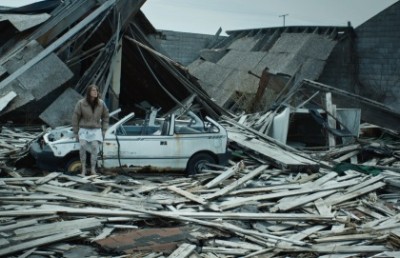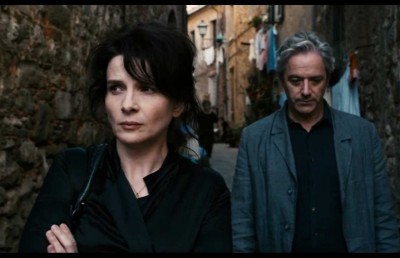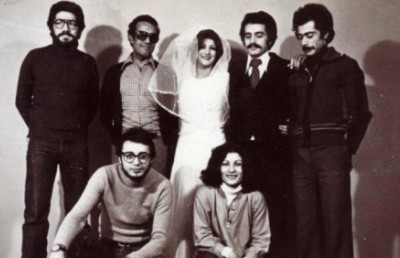An Interview with David Clay Diaz: On Agonie (2016)
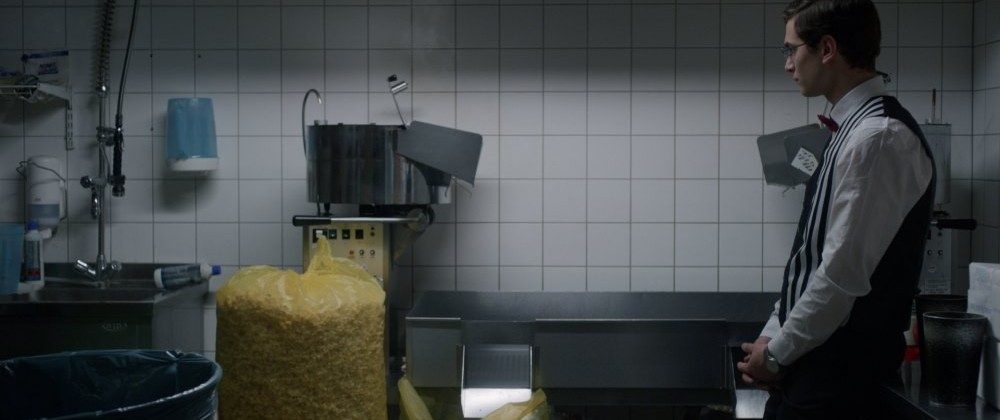
The Austrian/German co-production Agonie (2016, David Clay Diaz) received its North American premiere at the Fantasia International Film Festival 2016, after being an Official Selection at the Berlin International Film Festival 2016. Diaz’s Agonie takes an understated approach to a grisly real life murder: a young man murders his girlfriend with a kitchen knife, dismembers the corpse and deposits the body parts in different city dumpsters. These facts are given to us as a news feed, then Diaz builds slowly and inevitably toward this crime by presenting two possible suspects in methodical criss-cross fashion, the conservative looking Christian (Samuel Schneider), and the younger, punkish looking Alex (Alexander Srtschin). What grips the viewer is the knowledge that the murder will come, and the film’s controlled exercise in style that appears to suffocate the two characters in their disparate but equally stifling worlds. Though most viewers will probably figure out who the killer will be, when the murder does come it is shocking in its bluntness and intensity. Director Diaz kindly responded to my curiosity over the film.
Offscreen: Can you give us some of your biographical history David, and then how you became a filmmaker. Did you have any formal training in film?
David Clay Diaz: I was born 11th July 1989 in Asuncion, Paraguay, lived in Lima, Peru until I came to Vienna, Austria when 4 years old. My mother is Peruvian, my father is US American. I was raised in Vienna and after high school I studied two years Philosophy before I enrolled in Film School in Munich, Germany. That’s how I became a filmmaker: I studied it for nearly 5 years. Before I attended film school though I shot several short movies in Vienna.
Offscreen: I know the story of Agonie is based on a true crime story from Vienna. What sort of a news impact did that murder have in Vienna? How did people react to the news?
David Clay Diaz: It was bigger than others I guess, but maybe I just had the subjective feeling because I knew the victim and followed it more than other cases. But it was pretty special since there was no obvious reason for the crime and many contradictions, but also the way he murdered her and what he did to the corpse in real life was welcome fodder for the boulevard press. Also the murderer’s character was “different” I guess, he was a young, good looking white guy, studying law.
Offscreen: Yes, I found out through a mutual connection we share that you knew the real life victim of the crime. How well did you know the victim? And how did that trauma affect your approach to the film. Was it a way for you to deal with the tragedy?
David Clay Diaz: I only knew her very little. I met her a few times because we lived in the same neighborhood and during school we went to 2 or 3 parties, but we never really talked to each other. But seeing her, knowing her voice, the way she moved —it was very different to the reception of cases where you don’t know the human beings behind the case. Its only a name, a number, a fact. All of a sudden it was more for me. And I started to think about the meaning of death. Actually the beginning of this movie was a very much more philosophical approach. I remember I saw her mother at her balcony after the crime. She was hanging up washed clothes on the balcony to dry, all of a sudden she stopped and simply looked into nowhere, then she “woke up” again, finished what she was doing and entered the flat again. I was standing on the street and that moment was the beginning of the movie. That moment I felt how the movie should feel like. I had the very uncanny feeling that whatever reason you learn there might be for a murder, you will never really understand the meaning of the victim being gone. She’s dead now. Where is she now? What does that mean? That was the beginning.
Offscreen: In your film at the end, the killer leaves clues to suggest he will be caught, or wants to be caught, but we never know for sure. In reality, was the killer ever caught?
David Clay Diaz: In reality he was caught, yes.
Offscreen: Your film is part of a cycle recently of films dealing with teen or adolescent anomie. Your film is a crime film but it is also very much about young people dealing with alienation. How did you perceive of your film, as a crime film or a film dealing with young social alienation? Or both?
David Clay Diaz: I guess its both, yes…I mean on the superficial level it is obviously about a crime. But rather than working with the “who done it“ dramaturgy I worked differently, my focus was somewhere else. To say I was seeking for answers would not be adequate either. That’s why I guess i’ts also more than that.
Offscreen: In terms of the motivation for the murder, I like the fact that you paint a broad picture of varying factors, such as familial, economic, peer pressure, sexual identity, mental health, but do not offer any solution or direct reason. How did the decision to leave the motivation or reason behind the killing open, come about?
David Clay Diaz: As simple as disturbing as frustrating as true: because I don’t know. If I knew I would have given the answer. But I didn’t. I never found THE answer/reason.
Offscreen: The two actors you pick for the parts, the younger punkish Alex (Alexander Srtschin) and the studious Christian (Samuel Schneider), are wonderful. Most viewers will probably make up their own mind on who the killer is based on these stereotypes, but you subvert these to some extent. How did the casting for these two roles come about?
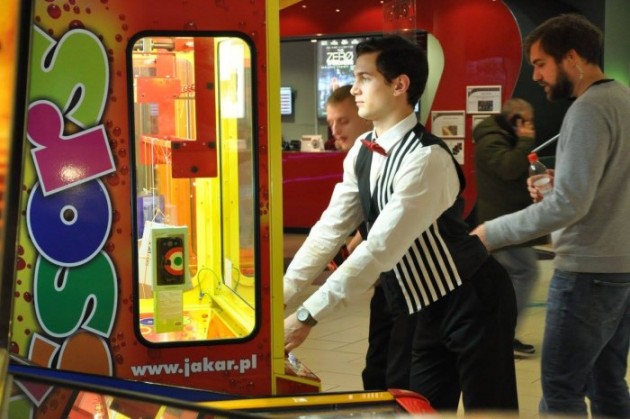
Samuel Schneider as Christian
David Clay Diaz: Samuel Schneider (Christian) is a professional young German actor. He won several prizes and had a leading role in Oscar winning director Caroline Link’s latest film Exit Marrakesh . I saw him on some pictures and some scenes and liked the expression of his eyes. He looks so…deeply hurt and sensitive, but kind of angry, focused…I liked that.
And Alexander Srtschin (Alex) has a very special story: he only accompanied her friend to another casting call about half a year before I even started working on the film. The casting director I worked with also cast this other movie and when she saw him she wanted him to try, but he refused. At the end she convinced him and she tried some improvised scenes. Later when I met her and told her about the story and characters she showed me the tape of Alex and we directly knew that he was the right guy!
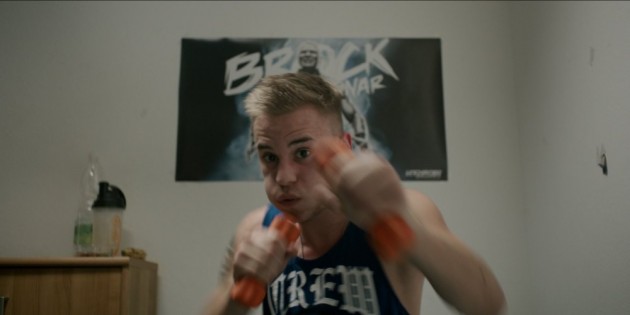
Alexander Srtschin, as Alex
Offscreen: Neither Alex or Christian seem comfortable in their skin. This is as much a result of their performance but also the film’s style. Since the two characters never meet I am curious, did the two actors ever meet? How was the shooting schedule for the two actors and their scenes?
David Clay Diaz: They met in real life, yes. Samuel lives in Berlin and Alex near Vienna. But Samuel, being the professional was impressed by Alex.The shooting schedule was strictly seperated, but more because of financing reasons than other reasons.We shot Christian’s scenes in winter 2014 and Alex’s in spring 2015. Wow time’s passing fast…
Offscreen: Was the film shot in chronological order or the usual way? How long was the shoot?
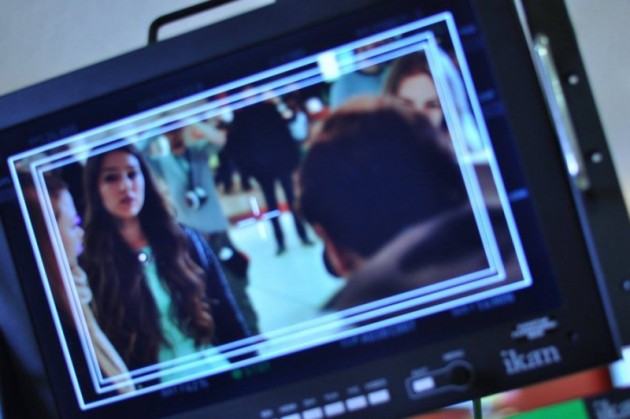
The on set Video Assist
David Clay Diaz: It was shot in the usual way. And each episode took 2 weeks to shoot. So in total 4 weeks for the whole movie.
Offscreen: The relationship that both Alex and Christian have with their parents is strained to say the least. The behavior between Alex and his father is particularly troubling. Masculinity seems to be a weight to bear for both Alex and his father. There’s an uncomfortable sexual element to how they interact. Can you expand a little on the relationship between Alex and his father.
David Clay Diaz: To be honest I only knew that their parents would shine through their absence. That is their impact on their kids: not being there at all. I was raised without a father, that’s why I guess I mostly write stories without fathers. But absence tells a lot too. Sometimes what is not there is even a stronger element than what is there. But yes in the end we kind of got some interactions between father and son, maybe its a deep wish of mine to interact with the father I never had, I don’t know. But I wanted their interactions to be filled with desire. A desire to cope with each other, to find intimacy. But they just don’t find the “proper” way to communicate these longings.
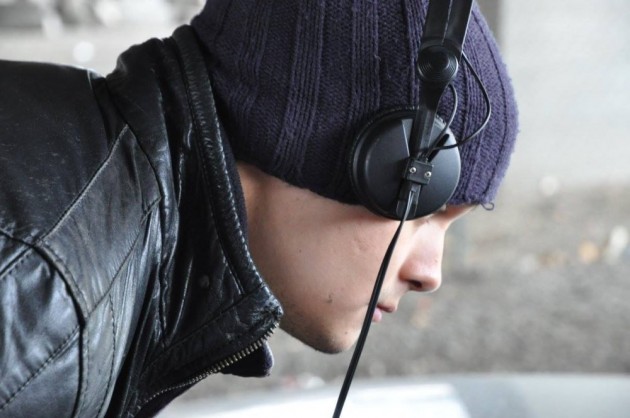
Director Diaz checks out a shot on the video assist
Offscreen: On the father again, the scene later where he opens up with his son shows a softer side to him that suggests his gruff persona as a cop is just a mask, an exterior. The flip side to that of course is the homoerotic or homosocial behavior between Alex and his friend. Is this a common part of masculinity in Vienna, to act ‘tough’?
David Clay Diaz: First of all I never thought of homosexuality as an aspect. I just wanted nearness. Of course the boys had their trouble with that scene (to come back to your answer if that masculinity is important: it is) but when I explained to them that it is more about intimacy that neither of them have but need, they totally got it. It was a beautiful moment.
And yes I guess masculinity, being tough is pretty important for young men, not only in Vienna but everywhere. If you asked my why? – I’m not sure, I guess its a way to position themselves, but of course it is something that is being indoctrinated.
Offscreen: In terms of the two characters I find it interesting that Alex seems the more aggressive but does things to vent his aggression, like the boxing, weight lifting, the video games, watching the real violence youtube videos, while Christian on the surface is non-violent. And yet, it is Christian who enacts on his violent tendencies. Did you plant a possible subtext with this point, casting suspicion on repression or conservative behavior, and suggesting a positive element to violent forms of entertainment?
David Clay Diaz: I do think that it is very important to show feelings. Unfortunately we don’t have much room in our society to show them and anytime you do you’re doing something extraordinary, something unusual. In our society it’s about functioning. There’s no much room for emotions. I guess that is why they are hidden and repressed until they must get out and only find weird, extreme ways.
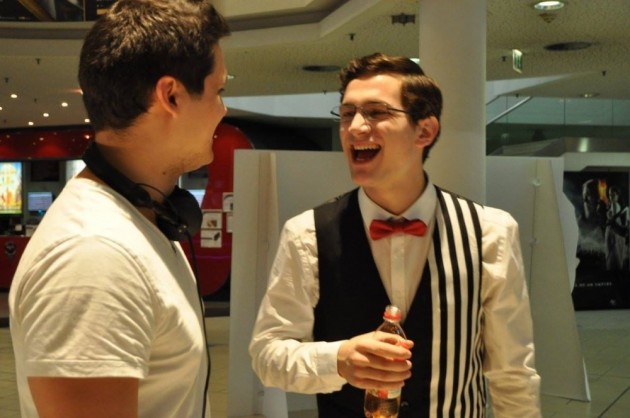
Diaz and Schneider share on on set laugh
Offscreen: I think Agonie owes much of its impact to a controlled exercise in style. The film is shot in a reserved, realistic manner, with long takes, static framing or subtle camera movements and judicious use of music. Can you talk a little about this style? Did you have any direct influences in mind when you conceived of shooting in this style?
David Clay Diaz: I can’t think of content and form being separate aspects of a movie. Of art. I always approach a content with a specific form, in visual art its actually THE WAY you tell that content. But not only, I mean you can write the same sentence in a novel in so many different ways: a squiggled, baroque sentence, beautiful to look at and read. It can also be very short sentences, sober and distanced. And it will have a different impact. It will tell something different. I totally love, worship European arthouse tradition. More than anything in the process of filmmaking I enjoy the process of writing and wish to see myself in the tradition of auteur filmmakers. Several European directors had and have a strong impact on me: Bergman, Haneke, but also Russian director Tarkovsky for example.
Offscreen: Why did you decide not to use any non-source music (music outside the on screen story)?
David Clay Diaz: I actually did – the theme in the middle and end of the movie. But I try not to exceed it, and not to use it in moments to underline the characters emotions, but rather maybe use it as a comment, or atmospheric tool. Otherwise it simply takes away the sense of realism I guess.
Offscreen: Although your style makes use of stillness, static shots, there are also some very impressive and expressive camera movements. Like the one about 43 minutes in that tracks slowly from the living room to Christian in the bathroom while we hear a radio report about a 14 year old girl who stabbed her mother. As the camera moves past the kitchen, we see the knives on the wall, and then it peers around the open bathroom door to frame Christian shaving his arm pits in the mirror. It is suspenseful without really containing any menace. It is just the movement itself which menaces. How conscious were you of alternating the rhythm across the film, from static to movement?
David Clay Diaz: The cinematographer and I talked a lot about the tone of the movie, the rhythm, how I wanted the movie to be felt. I always want cinema to be also an experience of sensation. And rhythm is not only a way to create a sensation (in this case of loneliness, tristesse, being lost, uncertainty) but also of course the tool to shape the form. Its like music. A row of loud, extreme tones might be felt as noise, but in an interval it is music, all of a sudden. (I’ve got to admit that by using the last sentence, the comparison with music I’m quoting Michael Haneke! )
Offscreen: I love the way the film crosscuts almost methodically between the two characters, without them ever meeting. Was the film always conceived with this dual structure?
David Clay Diaz: It was always conceived with the dual structure, yes! But I wrote and shot an encounter between them both. Well, they crossed path without talking to each other. But I cut it out since I realized I was only doing it because I had the feeling the audience expects it. In the end it didn’t tell anything. It was only there to please. Without any purpose, so I threw it away pretty early in editing process.
Offscreen: Wow. I would agree. I am happy you did cut it out. Even though the two characters live completely different lives, your reserved style serves to ‘trap’ the two dissimilar men in the same stifling world. Was this an intent of the style or an indirect result of the style?
David Clay Diaz: It was because though living different lives they do live in the same world.
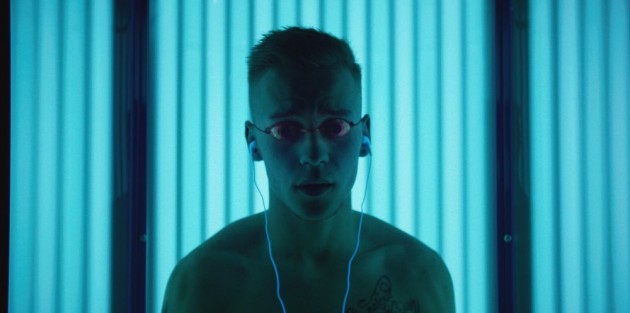
Homage to Gomorrah?
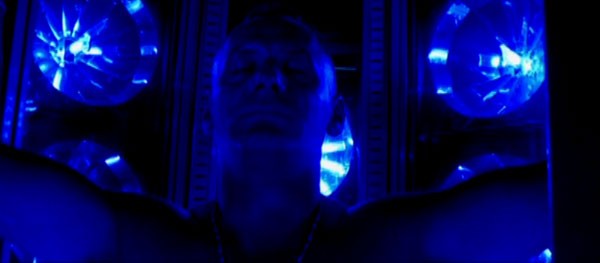
Offscreen: Your detailing of the Christian character through props and framing is very clever. For example, he seems to take a drink of water or milk whenever he is stressed. When his mother and lover ask him about his studies, more out of small talk than interest, you frame Christian in the kitchen getting milk from the fridge. He appears annoyed at their attitude. Behind him we see a row of knives on the wall, which not only foreshadows his murder weapon but stands in for his anger. And then later before he kills his girlfriend he drinks a glass of water, then grabs a knife. Why this link between aggression and drinking? Is there a reference to mental illness: to the medication he is not taking but should? This idea of illness is also supported through the art design of his bedroom, with all white bed, sheets, walls, radiator, that suggests a hospital or mental institute?
David Clay Diaz: To be honest I never intended any meaning behind that. It’s simply something one does, or I do. When I’m working or I’m stressed I drink something in my pauses, maybe because I don’t smoke. Others might smoke. Before the murder it was more to increase the suspense and to make it look more impulsive. I just thought that if he stands up and directly grabs the knife it would look like this was his purpose for standing up and going to the kitchen in the first place. But if he drinks a glass of water first – the grabbing of the knife, and the murder, might look more “spontanous“ and impulsive. But I really like and enjoy the interpretations and they make it much richer.
Offscreen: The murder itself, when it finally comes is abrupt and shocking. The overhead long take shot of the dead woman and her red streaks of blood against the white sheets is striking in its intensity and mix of beauty with the grotesque. Our eyes gravitate to the one thick blotch of blood on the left side of the bed that drips ever so slowly, like a moving painting. It has a very powerful impact. Can you talk a little about the intentions behind the choreography of the death scene, and your artistic treatment of violence?
David Clay Diaz: I had the feeling that this stillness, this calm might create the feeling of absurdity. To look at the lifeless body of this girl who just lived some seconds before, who was an individual with wishes, desires, full of life now lying there, only a shell, erased, doomed to decay, disappear…
Offscreen: I’ve learned that you have recently won a prestigious award, the Bavarian Culture Prize in Germany. Was it for Agonie?
David Clay Diaz: Yes.
Offscreen: Have you been able to sell Agonie to any markets? Is there a home video release in the future?
David Clay Diaz: Agonie will have a cinema release in Germany and Austria and will come out as DVD, VOD and on TV.
Offscreen: What’s next for you in terms of projects?
David Clay Diaz: I’m working on different scripts right now. One about refugee crisis in Europe, but focusing on European perspective. Different characters dealing in a very different way with that. A Literature adaptation about a young woman dealing with bulimia. And a pretty autobiographic movie. We’ll see which one will be shot first!
Offscreen: Thanks for taking the time to do this interview David.
David Clay Diaz: Thank you very much! I enjoyed these questions!
All photos provided by David Clay Diaz



